
by Carrie Stevenson | Jan 5, 2018
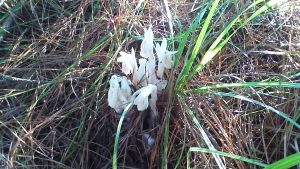
The ghost flower in full bloom. Photo credit: Carol Lord
Imagine you are enjoying perfect fall weather on a hike with your family, when suddenly you come upon a ghost. Translucent white, small and creeping out of the ground behind a tree, you stop and look closer to figure out what it is you’ve just seen. In such an environment, the “ghost” you might come across is the perennial wildflower known as the ghost plant (Monotropa uniflora, also known as Indian pipe). Maybe it’s not the same spirit from the creepy story during last night’s campfire, but it’s quite unexpected, nonetheless. The plant is an unusual shade of white because it does not photosynthesize like most plants, and therefore does not create cholorophyll needed for green leaves.
In deeply shaded forests, a thick layer of fallen leaves, dead branches, and even decaying animals forms a thick mulch around tree bases. This humus layer is warm and holds moisture, creating the perfect environment for mushrooms and other fungi to grow. Because there is very little sunlight filtering down to the forest floor, the ghost flower plant adapted to this shady, wet environment by parasitizing the fungi growing in the woods. Ghost plants and their close relatives are known as mycotrophs (myco: fungus, troph: feeding).
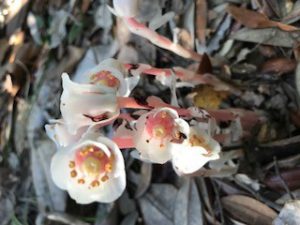
Ghost plant in bloom at Naval Live Oaks reservation in Gulf Breeze, Florida. Photo credit: Shelley W. Johnson
These plants were once called saprophytes (sapro: rotten, phyte: plant), with the assumption that they fed directly on decaying matter in the same way as fungi. They even look like mushrooms when emerging from the soil. However, research has shown the relationship is much more complex. While many trees have symbiotic relationships with fungi living among their root systems, the mycotrophs actually capitalize on that relationship, tapping into in the flow of carbon between trees and fungi and taking their nutrients.
Mycotrophs grow throughout the United States except in the southwest and Rockies, although they are a somewhat rare find. The ghost plant is mostly a translucent shade of white, but has some pale pink and black spots. The flower points down when it emerges (looking like its “pipe” nickname) but opens up and releases seed as it matures. They are usually found in a cluster of several blooms.
The next time you explore the forests around you, look down—you just might see a ghost!

by Carrie Stevenson | Jan 5, 2018

The swing hanging from our magnolia tree has provided many happy memories for our family. Photo credit: Carrie Stevenson
Do you have a favorite tree? Often, the trees in our lives tell a story.
One of the selling points when we bought our house 14 years ago was the tall, healthy Southern magnolia in the front yard. It was beautiful, and I could see it out my front window. A perfect shade tree, I could envision a swing hanging from its branches one day. Within six months of moving into the house, Hurricane Ivan struck. A neighbor’s tree fell and sheared off a quarter of the branches from our beloved magnolia. We were lucky to have minimal damage otherwise, and hoped the tree would survive.
The branches and leaves eventually filled in, and we added that swing I had imagined. One day I was pushing my daughter in the swing, when a car slowed on our street and stopped at our mailbox. A man stepped out and asked, “Are you enjoying that tree?” I responded that we very much were, and with a smile, he explained that his family built our house and that he planted that very magnolia tree 40 years before, when his son was born. He was so happy to see us enjoying the tree that he could not help but stop.
I was so grateful to hear that story and know that our family’s favorite tree held such special meaning. Our enjoyment existed because of the joyous celebration of a new birth. That is why we plant trees. For the benefit of those yet unborn, to commemorate special moments, and to provide the very oxygen we breathe. As the Greek proverb goes, “Society grows great when old men plant trees whose shade they know they shall never sit in.”
January 19 is Florida’s Arbor Day, a time to celebrate the many benefits of trees, and the day is often celebrated by planting new trees. Winter is the best time of year to plant trees, as they are able to establish roots without competing with the energy needs of new branches and leaves that come along in springtime.
“The best time to plant a tree is twenty years ago. The second best time is now.” –Anonymous
Check with your local Extension offices, garden clubs, and municipalities to find out if there is an Arbor Day event near you! Several local agencies have joined forces to organize tree giveaway events in observance of Florida’s Arbor Day.
Escambia County:
Thursday, January 18:
Deadline for UF IFAS Extension/Escambia County’s second annual Arbor Day Mail Art Contest. To participate, mail a drawing, painting, or mixed media artwork with the theme, “Strong Trees, Strong Communities” to Arbor Day Art Contest c/o Escambia County Extension, 3740 Stefani Road, Cantonment, FL 32533. Please include your name, age, and contact information on the back of your artwork. Contest entries must arrive by mail or be dropped off by Jan. 18 and will be judged at the tree giveaway on Jan. 20 at Barrineau Park Community Center.
First place winners of the art contest will receive prizes including a seven-gallon tree, a shovel, and a tree book. Second place winners will receive a tree book and third place winners will receive gardening gloves. Categories include children (12-under), teen (13-18), and adult (over 18). All participants in attendance at the tree giveaway will receive a special edition Arbor Day water bottle featuring last year’s winning design.
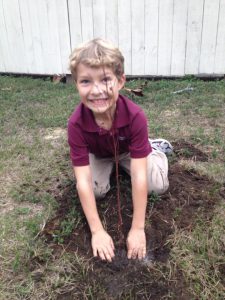
Many communities plant trees to celebrate Arbor Day. Photo credit: Carrie Stevenson
Saturday, January 20th
Escambia County will hold their tree giveaway and public planting from 10 a.m. to noon Saturday, Jan. 20 at Barrineau Park Community Center, located at 6055 Barrineau Park Road, Molino. Support for the event is provided by the Florida Forest Service, Resource Management Services, and Escambia County UF-IFAS Extension. Each attendee will receive two free native 1-gallon trees. Species available include tulip poplar, Chickasaw plum, Shumard oak, and fringetree.
For more information about either Escambia event, contact Carrie Stevenson, Coastal Sustainability Agent III, UF IFAS Extension, at 850-475-5230 or ctsteven@ufl.edu.
Santa Rosa County:
Friday, January 19
10 am—Navarre Garden Club Arbor Day celebration. Foresters will give away 1-gallon containerized trees and conduct a have tree planting demo. 7254 Navarre Parkway, Navarre, 32566. For more information, contact Mary Salinas, 850-623-3868 or maryd@santarosa.fl.gov
Saturday, January 20th
10 am—Milton Garden Club Arbor Day celebration. Foresters will give away 1-gallon containerized trees and conduct a have tree planting demo. 5256 Alabama Street, Milton. For more information, contact Mary Salinas, 850-623-3868 or maryd@santarosa.fl.gov
Leon County:
Saturday, January 20th
9am to 12pm – City of Tallahassee/Leon County Arbor Day Celebration – Join City and County Staff, UF/IFAS Leon County Extension Faculty and Master Gardener volunteers at the Apalachee Regional Park (7550 Apalachee Pkwy) for a tree planting in honor of Arbor Day. Citizens are invited to come help plant hundreds of trees in the park and also learn about the benefits of trees, how to properly plant a tree, and after the planting is done, take a tree identification walk. For more information, contact Mindy Mohrman, City/County Urban Forester at 850.891.6415 or melinda.mohrman@talgov.com
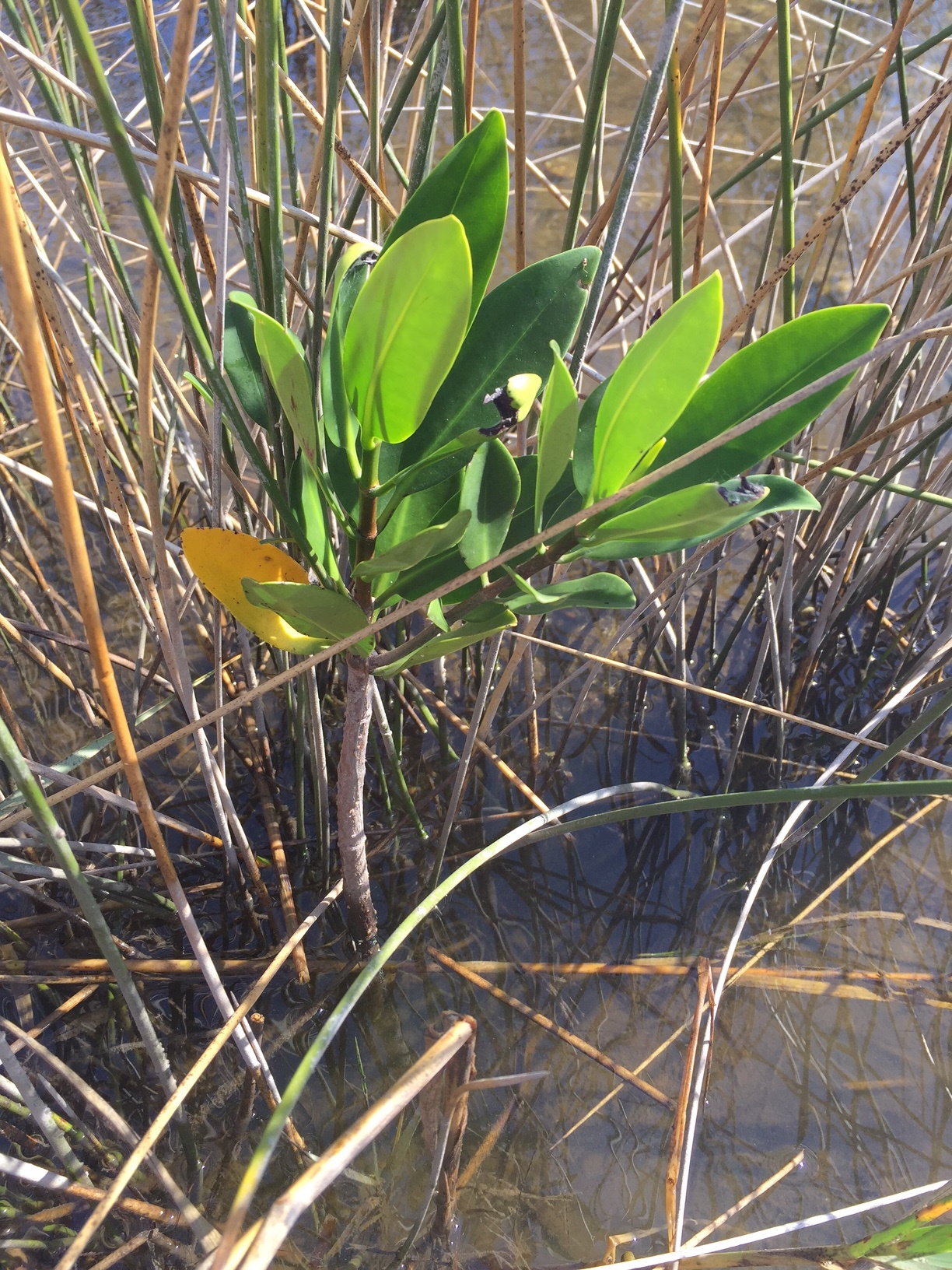
by Carrie Stevenson | Nov 3, 2017
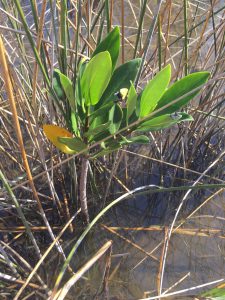
Red mangrove growing among black needlerush in Perdido Key. Photo credit: Carrie Stevenson, UF IFAS Extension
Discovering something new is possibly the most exciting thing a field biologist can do. As students, budding biologists imagine coming across something no one else has ever noticed before, maybe even getting the opportunity to name a new bird, fish, or plant after themselves.
Well, here in Pensacola, we are discovering something that, while already named and common in other places, is extraordinarily rare for us. What we have found are red mangroves. Mangroves are small to medium-sized trees that grow in brackish coastal marshes. There are three common kinds of mangroves, black (Avicennia germinans), white (Laguncularia racemosa), and red (Rhizophora mangle).
Black mangroves are typically the northernmost dwelling species, as they can tolerate occasional freezes. They have maintained a large population in south Louisiana’s Chandeleur Islands for many years. White and red mangroves, however, typically thrive in climates that are warmer year-round—think of a latitude near Cedar Key and south. The unique prop roots of a red mangrove (often called a “walking tree”) jut out of the water, forming a thick mat of difficult-to-walk-through habitat for coastal fish, birds, and mammals. In tropical and semi-tropical locations, they form a highly productive ecosystem for estuarine fish and invertebrates, including sea urchins, oysters, mangrove and mud crabs, snapper, snook, and shrimp.
Interestingly, botanists and ecologists have been observing an expansion in range for all mangroves in the past few years. A study published 3 years ago (Cavanaugh, 2014) documented mangroves moving north along a stretch of coastline near St. Augustine. There, the mangrove population doubled between 1984-2011. The working theory behind this expansion (observed worldwide) is not necessarily warming average temperatures, but fewer hard freezes in the winter. The handful of red mangroves we have identified in the Perdido Key area have been living among the needlerush and cordgrass-dominated salt marsh quite happily for at least a full year.

Key deer thrive in mangrove forests in south Florida. Photo credit: Carrie Stevenson, UF IFAS Extension
Two researchers from Dauphin Island Sea Lab are planning to expand a study published in 2014 to determine the extent of mangrove expansion in the northern Gulf Coast. After observing black mangroves growing on barrier islands in Mississippi and Alabama, we are working with them to start a citizen science initiative that may help locate more mangroves in the Florida panhandle.
So what does all of this mean? Are mangroves taking over our salt marshes? Where did they come from? Are they going to outcompete our salt marshes by shading them out, as they have elsewhere? Will this change the food web within the marshes? Will we start getting roseate spoonbills and frigate birds nesting in north Florida? Is this a fluke due to a single warm winter, and they will die off when we get a freeze below 25° F in January? These are the questions we, and our fellow ecologists, will be asking and researching. What we do know is that red mangrove propagules (seed pods) have been floating up to north Florida for many years, but never had the right conditions to take root and thrive. Mangroves are native, beneficial plants that stabilize and protect coastlines from storms and erosion and provide valuable food and habitat for wildlife. Only time will tell if they will become commonplace in our area.
If you are curious about mangroves or interested in volunteering as an observer for the upcoming study, please contact me at ctsteven@ufl.edu. We enjoy hearing from our readers.
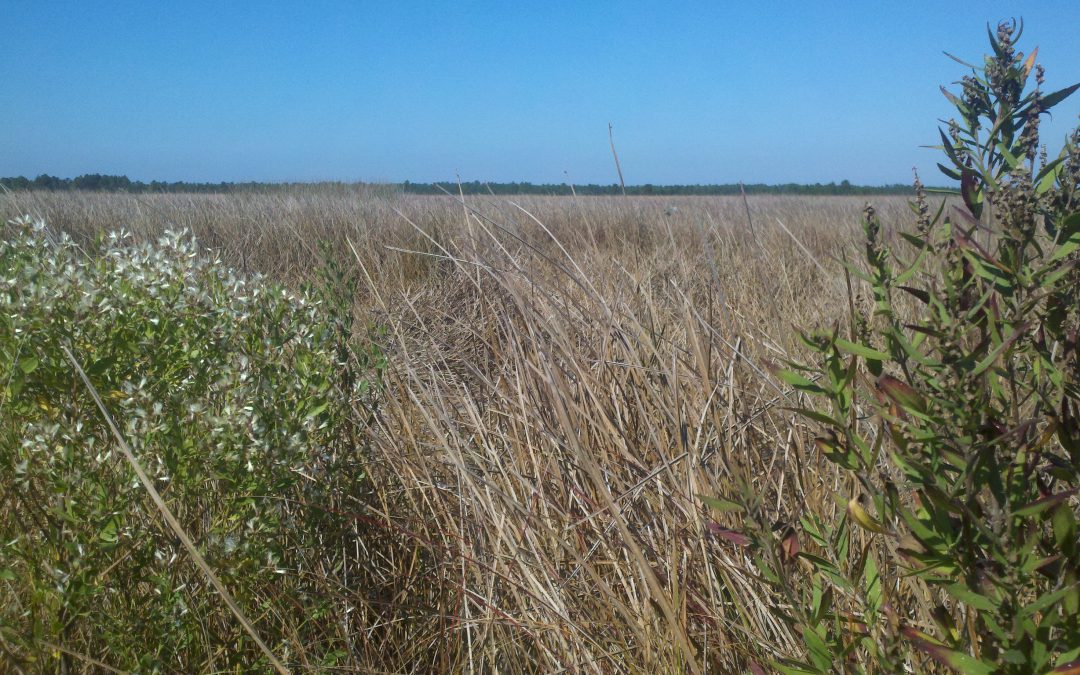
by Carrie Stevenson | Aug 25, 2017
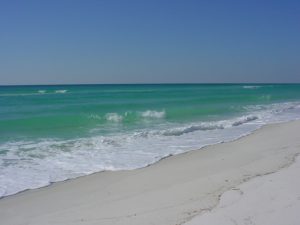
Life on the Gulf Coast can be beautiful, but has its share of complications. Photo credit: Carrie Stevenson, UF IFAS Extension
Life on the coast has tremendous benefits; steady sea breezes, gorgeous beaches, plentiful fishing and paddling opportunities. Nevertheless, there are definite downsides to living along it, too. Besides storms like Hurricane Harvey making semi-regular appearances, our proximity to the water can make us more vulnerable to flooding and waterborne hazards ranging from bacteria to jellyfish. One year-round problem for those living directly on a shoreline is erosion. Causes for shoreline erosion are wide-ranging; heavy boat traffic, foot traffic, storms, lack of vegetation with anchoring roots, and sea level rise.
Many homeowners experiencing loss of property due to erosion unwittingly contribute to it by installing seawalls. When incoming waves hit the hard surface of the wall, energy reflects back and moves down the coast. Often, an adjacent homeowner will experience increased erosion and bank scouring after a neighboring property installs a seawall. This will often lead that neighbor to install a seawall themselves, transferring the problem further.

Erosion can damage root systems of shoreline trees and grasses. Photo credit: Carrie Stevenson, UF IFAS Extension
Currently, south Louisiana is experiencing significant coastal erosion and wetlands losses. The problem is compounded by several factors, including canals dredged by oil companies, which damage and break up large patches of the marsh. Subsidence, in which the land is literally sinking under the sea, is happening due to a reduced load of sediment coming down the Mississippi River. Sea level rise has contributed to erosion, and most recently, an invasive insect has caused large-scale death of over 100,000 acres of Roseau cane (Phragmites australis). Add the residual impacts from the oil spill, and you can understand the complexity of the situation.
Luckily, there are ways to address coastal erosion, on both the small and large scale. On Gulf and Atlantic beaches, numerous coastal communities have invested millions in beach renourishment, in which offshore sand is barged to the coast to lengthen and deepen beaches. This practice, while common, can be controversial because of the cost and risk of beaches washing out during storms and regular tides. However, as long as tourism is the #1 economic driver in the state, the return on investment seems to be worth it.
On quieter waters like bays and bayous, living shorelines have “taken root” as a popular method of restoring property and stabilizing shorelines. This involves planting marsh grasses along a sandy shore, often with oyster or rock breakwaters placed waterward to slow down wave energy, and allow newly planted grasses to take root.
Locally in Bayou Grande, a group of neighbors were experiencing shoreline erosion. Over a span of 50 years, the property owners used a patchwork of legally installed seawalls, bulkheads, rip rap piles, private boat ramps, piers, mooring poles and just about anything else one can imagine, to reduce the problem. Over time, the seawalls and bulkheads failed, lowering the property value of the very property they were meant to protect and increasing noticeable physical damage to the adjacent properties.”

Project Greenshores is a large-scale living shoreline project in Pensacola. Photo credit: Carrie Stevenson, UF IFAS Extension
In 2011, a group of neighboring property owners along the bayou decided to take action. After considering many repair options, the neighbors decided to pursue a living shoreline based on aesthetics, long-term viability, installation cost, maintenance cost, storm damage mitigation and feasibility of installation. By 2017, the living shoreline was constructed. Oyster shell piles were placed to slow down wave energy as it approached the transition zone from the long fetch across the bayou, while uplands damage was repaired and native marsh grasses and uplands plants were restored to slow down freshwater as it flowed towards the bayou. Sand is now accruing as opposed to eroding along the shoreline. Wading shorebirds are now a constant companion and live oysters are appearing along the entire 1,200-foot length. Additionally the living shoreline solution provided access to resources, volunteer help, and property owner sweat equity opportunities that otherwise would have been unavailable. An attribute that has surprisingly appeared – waterfront property owners are now able to keep their nicely manicured lawns down to within 30 feet of the water’s edge. At that point, the landscape immediately switches back to native marsh plants, which creates a quite robust and attractive intersection. (Text and information courtesy Charles Lurton).
Successes like these all over the state have led the Florida Master Naturalist Program to offer a new special topics course on “Coastal Shoreline Restoration” which provides training in the restoration of living shorelines, oyster reefs, mangroves, and salt marsh, with focus on ecology, benefits, methods, and monitoring techniques. Keep an eye out for this course being offered near you. If you are curious about living shorelines and want to know more, reach out to the Florida Department of Environmental Protection Ecosystem Restoration section for help and read through this online document.
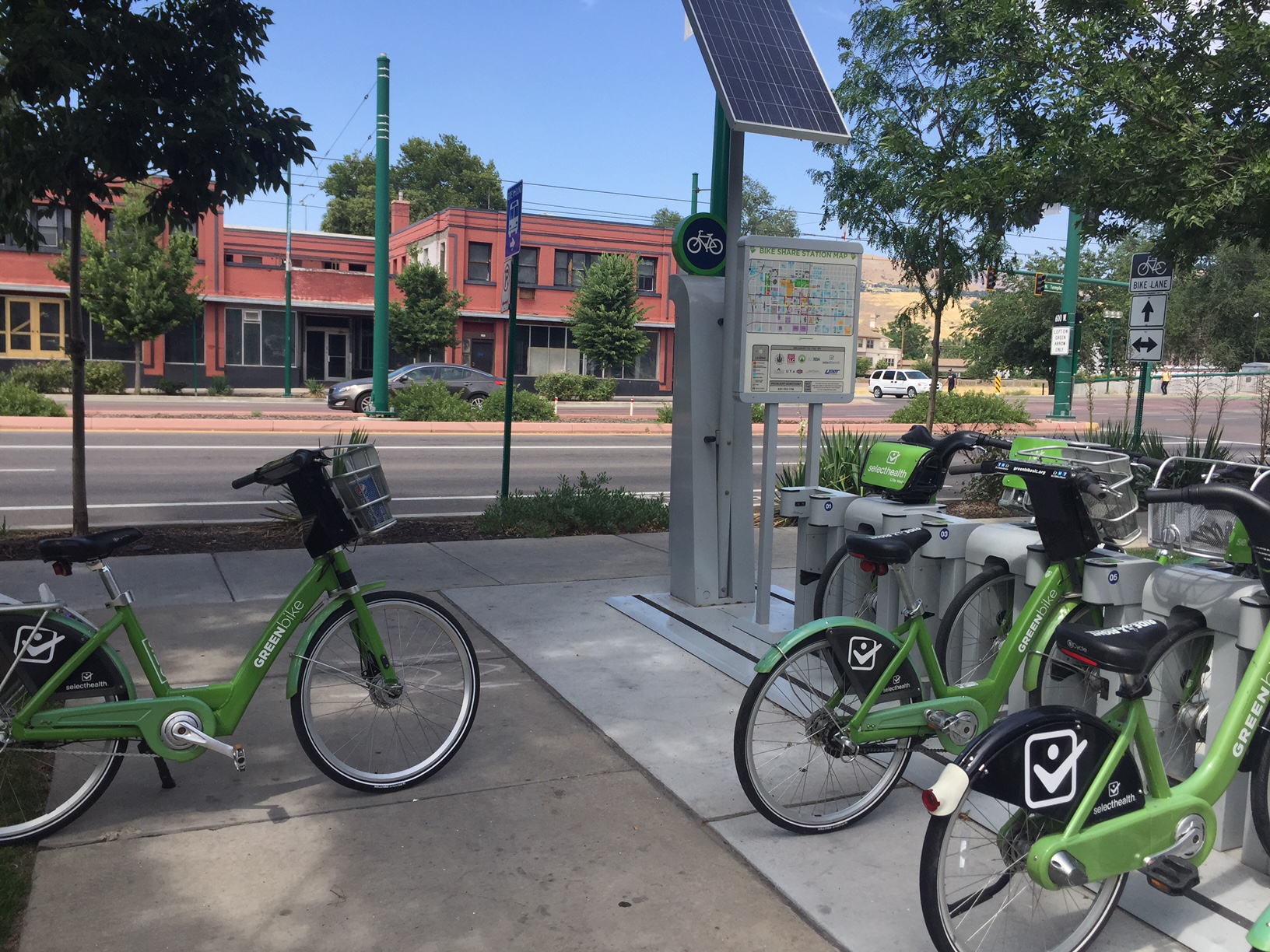
by Carrie Stevenson | Jul 14, 2017
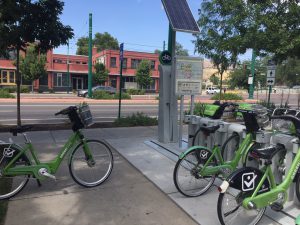
This solar-powered bicycle rental facility provides a healthy alternative to driving around a large city. Photo credit: Carrie Stevenson, UF IFAS Extension
Climate change is one of those topics that most people don’t want to think much about. It can be overwhelming, it can be controversial, and it can be downright frightening. A year ago, Yale and George Mason University completed the most recent surveys in the “Six Americas” study, which determined levels of belief and concern in global warming. The “Six Americas” range from people who are alarmed, concerned, cautious, disengaged, doubtful, or dismissive when asked about climate change. Interestingly enough, 34% of Americans consider themselves concerned while 23% were cautious. Ranking third were 11% who are doubtful about climate change.
When you start to drill down into the individual questions asked on the survey, you see more agreement. For example, when Escambia County citizens were asked whether global warming is caused by human activities, somewhere between 45%-50% said yes. However, when asked whether they think global warming is actually happening (regardless of cause), the percentage went up to 65%-70%. When asked if they support funding research into renewable energy sources, Escambia County residents jumped up to an 80%-85% agreement. That, to me, is nothing short of a miracle, having lived in Escambia County long enough to know there’s rarely that much agreement on anything!
The takeaway message from that survey, to me, is that regardless of where people stand on climate change/global warming, there are some starting points that can be common ground. If the majority of a community believe climate change is happening and that supporting renewable energy research is a good thing, then they can work towards those outcomes to the mutual benefit of all.
An example of one small but significant step towards sustainable energy use includes bicycle share/rental facilities. On a recent trip to Salt Lake City, solar-powered bike stations were strategically placed around the downtown area. For a small fee, the bicycles could be checked out (for 30 minutes at a time) up to 24 hours. This ensures there are plenty of bicycles available for other users, and stations are close enough to one another that it’s easy to check bikes in and out if you need more time. The benefits of encouraging bicycles are numerous; reduced traffic and burning of fossil fuels, reduced need for parking in high-value real estate, and health benefits for riders. The other investment necessary to make biking more prevalent and successful are bike lanes, which were plentiful in Salt Lake City to keep riders and drivers safe. Once safe bike lanes are in place, those who live in the area with their own bikes are more likely to use them on a regular basis, further decreasing vehicular traffic.
There are many great organizations and publications around the country dedicated to increasing bicycle use and safety. For more information, check out Trail Link, Momentum Magazine, or the Burlington Bikeway.















